The app marketplace has become so packed that it can be a nightmare to enter as an app marketer.
However, mastering in-app events can make your app visible through extensive testing and strategic efforts.
The purpose of these in-app events is not only about providing fun for the user but also about getting featured in the App Store, maximizing your app’s reach and engagement.
Once you understand the significance of in-app events to App Store Optimization (ASOApp Store Optimization, a process of improving the visibility of a mobile app in an app store.), a world full of opportunity opens up for your app and brand.
In this guide, we are going to explore various ways in-app events can revolutionize your ASO efforts.
- Strategic in the Right Place: The Importance of In-App Events for Your ASO
- In-App Events that Boost ASO Results
- Winning In-App Events: Practices for Successful Designs
- Driving User Retention & Downloads through In-App Events
- 10 Tools and Tips to Manage In-App Events for ASO
- How In-App Events Can Change Your ASO Game
- In-App Events for ASO: FAQs
Strategic in the Right Place: The Importance of In-App Events for Your ASO
In-app events are one of the most underappreciated and undervalued assets for your ASO strategy.
But they can have a huge influence on app store rankings, user engagementThe level of interaction and participation users have with your app., and new downloads.
But what are in-app events fundamentally, and how can they assist you within the confines of ASO?
For instance, in-app events are events that take place within an app, offering your users timely experiences.
- Exclusive promotions
- Seasonal offers
- New content drops
- Time-limited challenges
When used correctly, in-app events provide a timely means to remind both existing and potential users of your app.
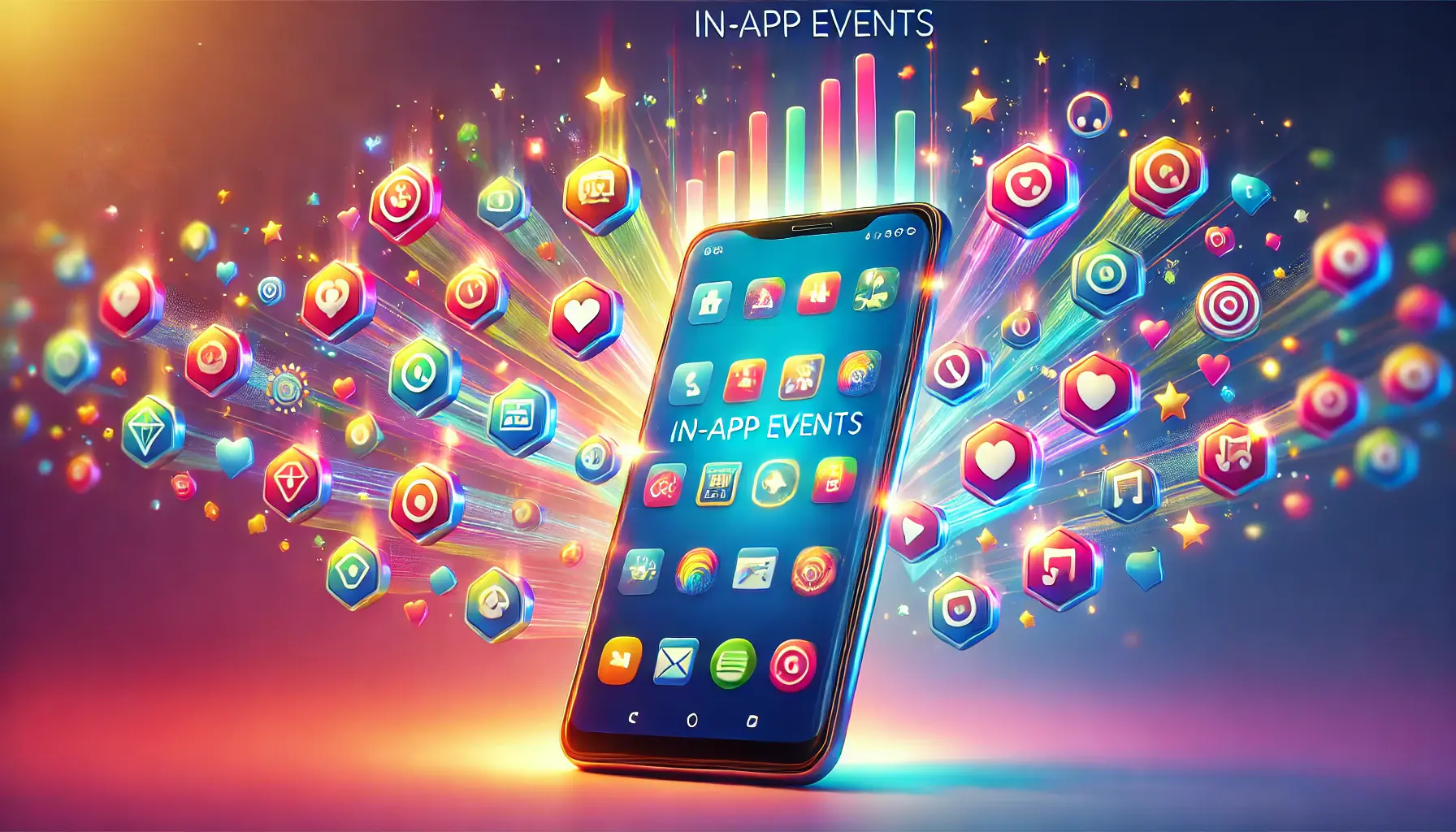
Highlighting the significance of in-app events in driving user engagement within mobile apps.
In-App Events: What They Mean and Why They Matter
In-app events are curated experiences that help drive customer retentionThe ability to keep users engaged and returning to the app over time. by reaching out to users at the right moments.
These events can include anything from game tournaments and holiday specials to major updates that highlight new app features.
These events are featured prominently in the App Store, where your app benefits from increased exposure, bringing it to the attention of users who might otherwise never know about it.
Why do they matter?
To put it simply, they allow your app to stand out.
In-app events are showcased in multiple locations on the App Store, including search results, editorial collections, and other places, all of which direct users to your app’s product page.
More downloads mean more exposure, which can lead to higher click-through rates, better rankings, and, overall, increased revenue for your app.
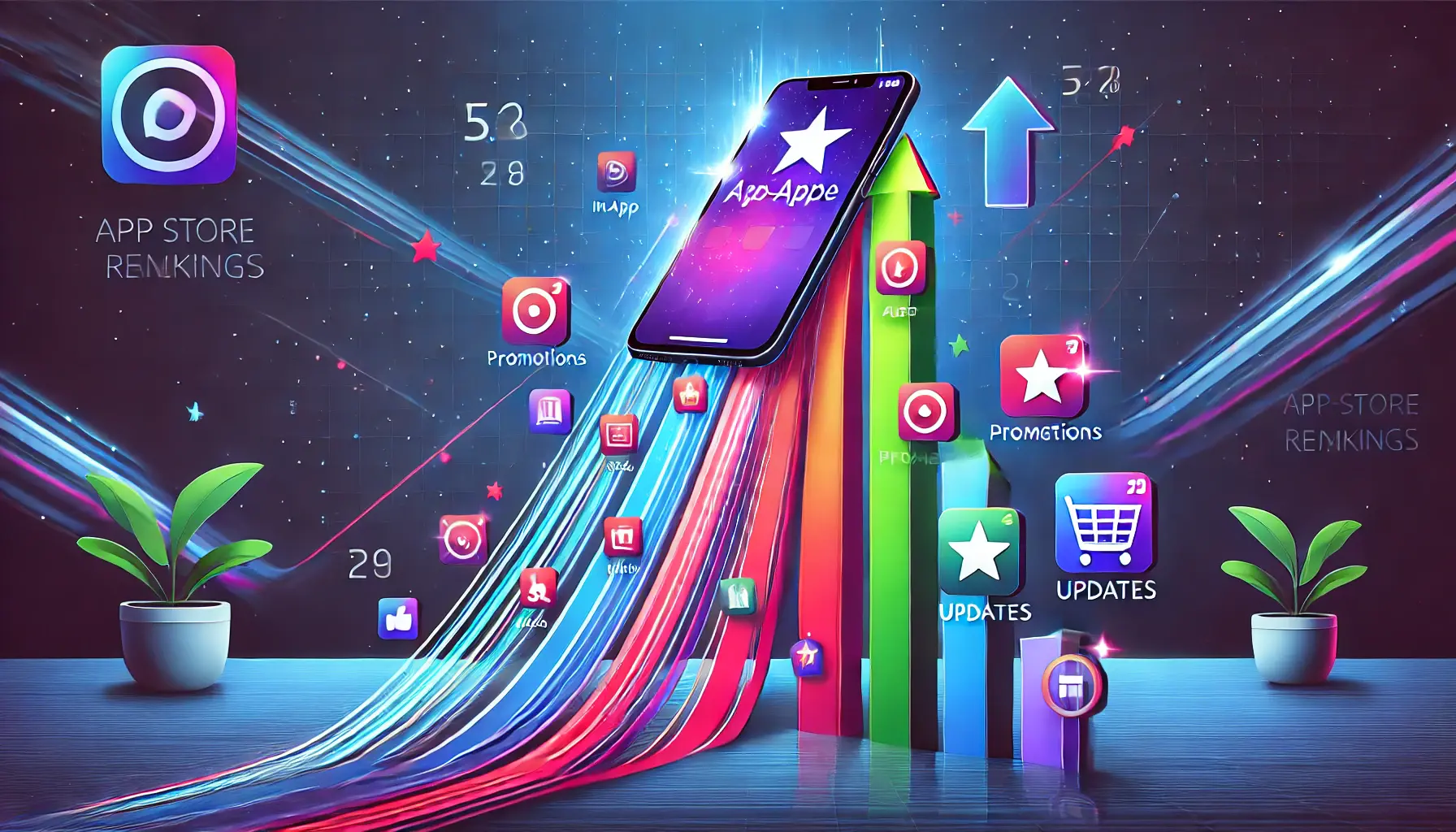
Visualizing the impact of in-app events on improving app store rankings.
The Effect of In-App Events on App Store Rankings
In-app events influence App Store rankings in multiple ways.
For one, users engaging in your events reflect positively on your app’s activity metrics, which is a key factor in determining app rank.
The more active your users, the better your app performs in the App Store algorithm.
Additionally, by consistently updating your app with new events, you signal to Apple’s algorithm that your app is relevant and valuable to users.
This not only helps maintain your current rankings but can also help improve them over time as engagement increases.

Illustrating the role of in-app events in driving long-term success for App Store Optimization (ASO).
Making Use of In-App Events for Long-Term ASO Success
For long-term ASO success, consistency in in-app events is crucial.
When you plan and host events that appeal to your audience, users are more likely to return to your app.
Regularly updating your app with meaningful events keeps it fresh and encourages users to stay engaged.
Combined with a robust ASO strategy, these in-app events could offer your app the ongoing activity and engagement required to maintain visibility and market share.
That begs the question: how often are you updating your app with significant in-app events?
Do your events appeal to what users are interested in or need?
The more you can think ahead and host events based on what your users truly care about, the better position your app will be in when it comes time to compete in the App Store.

Demonstrating how in-app events lead to better ASO results with increased app rankings and downloads.
In-App Events that Boost ASO Results
While in-app events contribute to obtaining ASO results, not all of them are equal.
Some events are especially effective in driving app discoverability and downloads.
To crack the world of ASO, start by learning how in-app events affect App Store or Play Store rankings.

Illustrating the diverse key types of in-app events that influence ASO and app performance.
Events that Impact ASO (Key Types)
The following are a few of the most influential in-app events for boosting your app’s performance in the Play Store:
- Sales events: A sale is a temporary offer or discount, designed to attract new users and entice current users back to your app. Promotional events create a sense of urgency, leading to more downloads and user activity.
- Seasonal events: Tie your in-app events to specific holidays or occasions such as Christmas or New Year to captivate users during festive seasons. Seasonal events help your app remain relevant and visible during peak times of the year.
- Achievement-based events: These events reward users for reaching milestones or completing specific goals within your app. With the gamification factor, achievement-based in-app events increase user engagement and retention, which ultimately has a positive impact on your ASO.
- Content events: Launching new features, stages, or utilities within your app can encourage re-engagement and attract both current users and new downloads. Regularly providing fresh content keeps your app at the forefront of users’ minds.
Each of these in-app event types has its unique way of driving more engagement and improving user traffic within your app.
The more your events are aligned with user interests and market trends, the better you can enhance your ASO strategy.
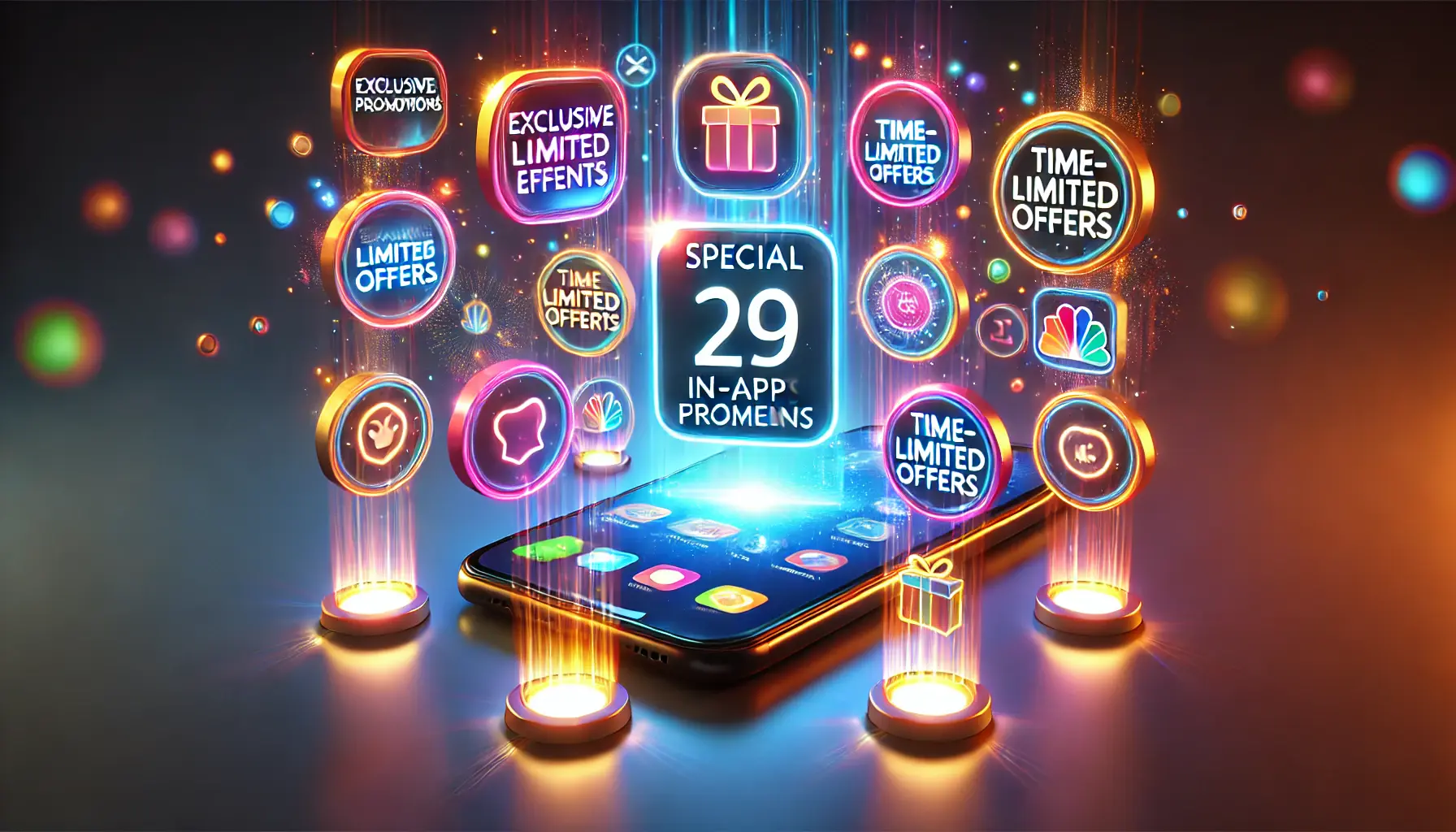
Showcasing special in-app events and promotions that stand out by capturing user attention with their vibrant and dynamic design.
Special Events and Promotions: Making Your Event Stand Out
Special in-app events and promotions, whether seasonal or time-bound, are the most effective tools for boosting engagement and driving downloads.
By associating your events with specific dates or periods, you create a natural incentive for users to engage when they otherwise might not have.
Seasonal and holiday promotions are particularly impactful because consumers are primed to buy during these times.
Promotions, meanwhile, create urgency.
Offering limited-time discounts or coupons triggers immediate user actions.
Whether it’s a seasonal celebration or a flash sale, these in-app events provide opportunities to engage new users and re-engage with current users.

Visualizing achievement-oriented in-app events that reward users with badges, trophies, and progress milestones to boost their profiles.
Boost Your Profile with Achievement-Oriented Events
Achievement-based in-app events are a great way to increase user retention and make your app more shareable, leading to more installs.
By rewarding users for completing small tasks within your app, you encourage them to continue using it.
Achievement-based events can range from reaching a specific level in a game to completing particular tasks within the app.
When users are rewarded for their efforts, they are more likely to stay active within your app.
This increased engagement not only boosts retention but also sends signals to the App Store or Play Store algorithm that your app is worth promoting.
The result?
Increased App Rankings and Visibility.
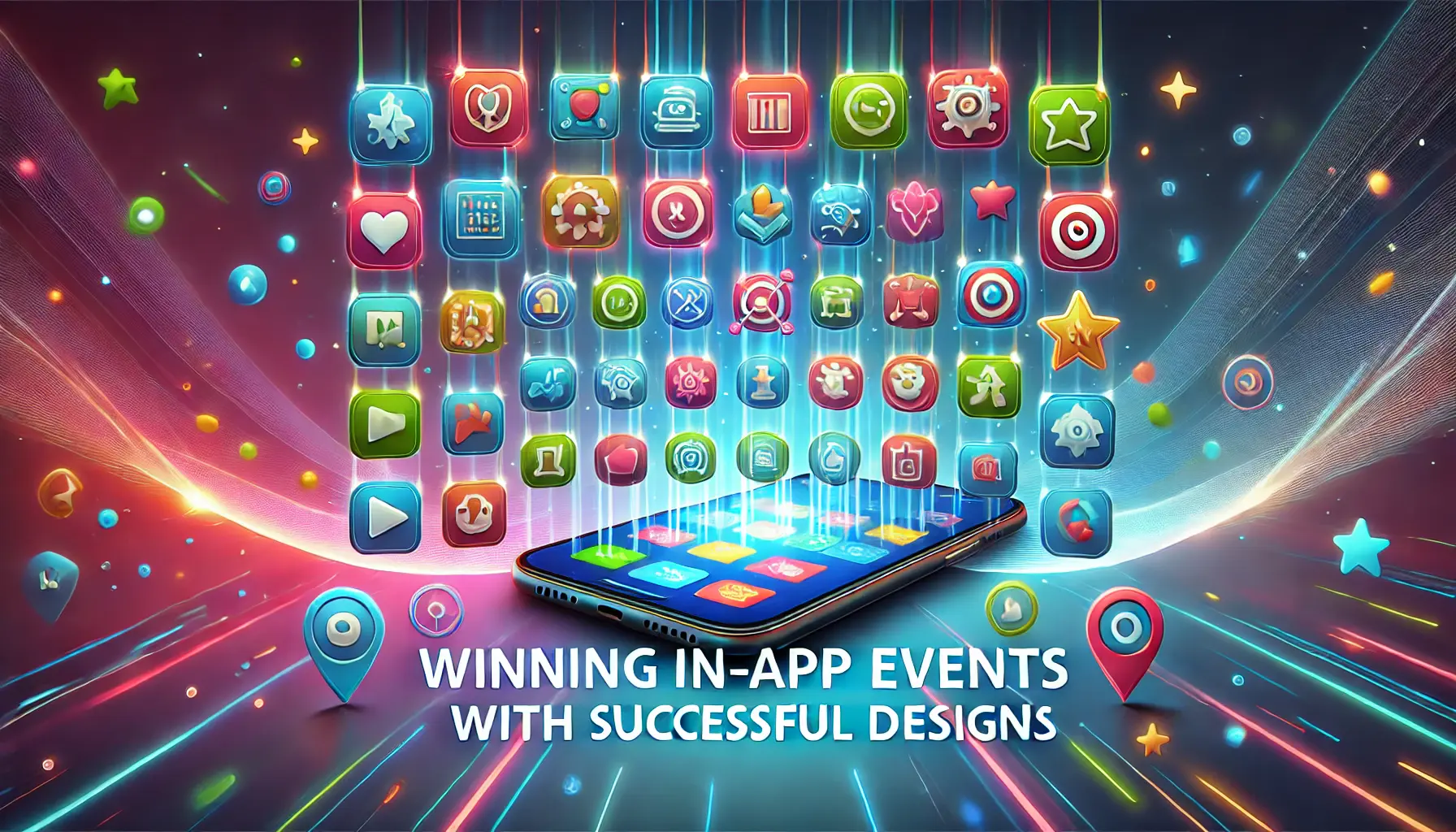
Illustrating winning in-app events through successful designs that captivate and engage users.
Winning In-App Events: Practices for Successful Designs
To encourage in-app actions, productive in-app events have many ingredients.
However, success does not happen by simply clicking a random creative banner.
Your in-app events must enhance your ASO, and for this to happen, you need to follow best practices that will help you focus on creating an event that is interactive and performs effectively.

Visualizing the thoughtful selection process for choosing the appropriate in-app event to enhance app engagement.
Selecting the Appropriate Event for Your App
The performance of your in-app events depends largely on selecting events that are consistent with your app’s purpose as well as your audience’s interests.
What are the most important things for your users?
Is it new features, challenges among users, or offers of discounts?
The trick is to choose in-app events that appeal to your target market and motivate them in a meaningful way.
- Applicable event: Make sure the event is related to what your app does. For example, a gaming app can set up a tournament for that month, whereas an e-commerce app might have a huge sale or launch an exclusive product for the week.
- User behavior: Tailor events to user preferences and behaviors. Monitor and mimic historical engagement drivers to create events that cater to your audience.
As long as you provide options that cater to your audience, they will show up, and this definitely helps generate buzz when you release new events.
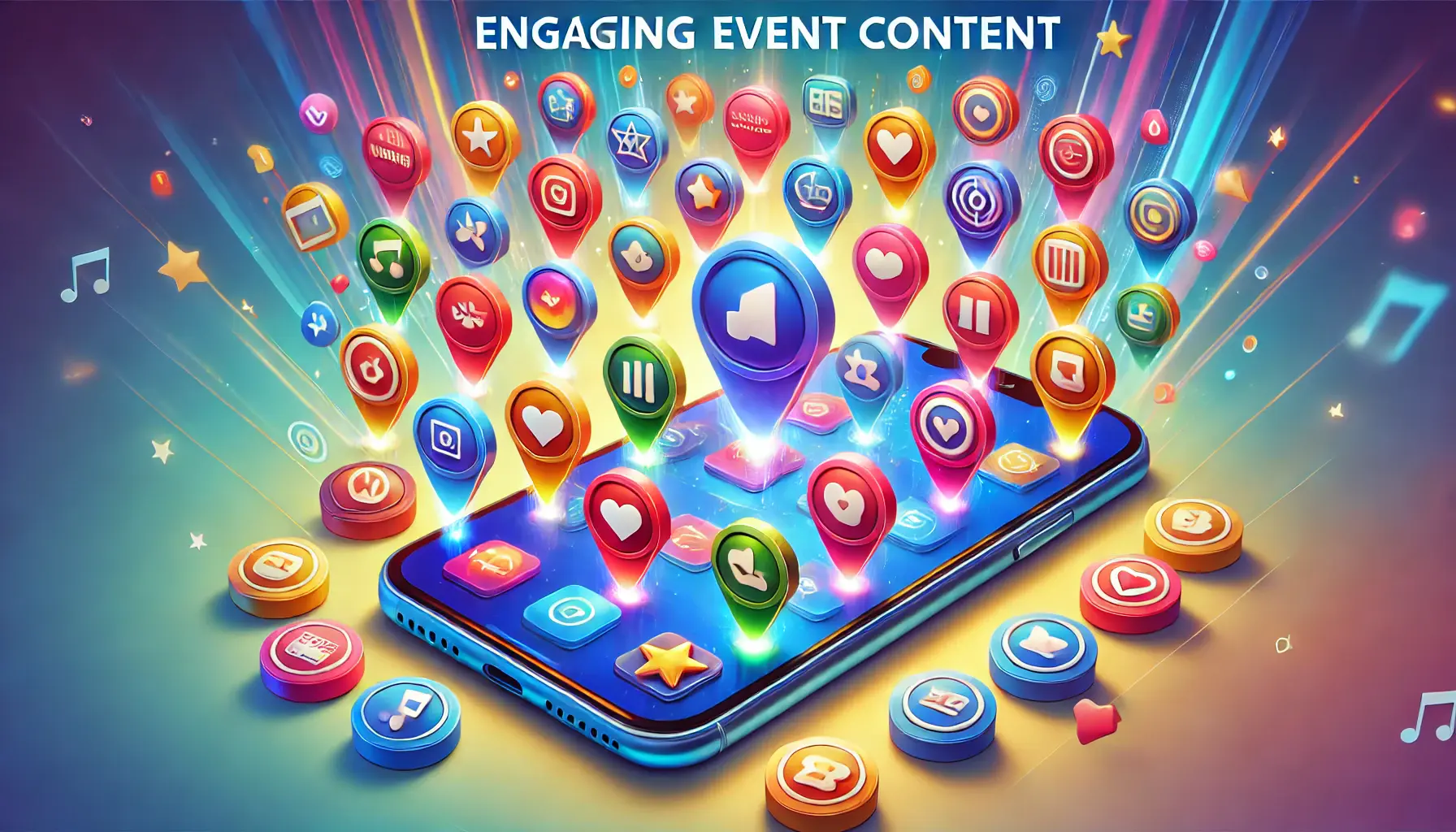
Illustrating the power of engaging event content in creating interactivity and excitement within a mobile app.
Engaging Event Content
The lifeblood of successful in-app events is engagement.
The first thing a user notices in your app is the content!
How you frame your event, the images that accompany it, and how easy it is for users to participate will determine its success.
- Visuals: Use high-quality, appealing graphics that stand out and give the feel of a special event.
- Clear messaging: Ensure the purpose and benefits of attending the event are communicated clearly to your audience. When users participate, they must immediately understand why they should respond and what is in it for them.
- Uncomplicated entry: Make it straightforward for users to sign up for the event. This way, you make it very easy for users to enroll and gain access to the event’s features.
Event content should engage users and, in turn, encourage more participation and downloads, which will ultimately enhance your ASO.
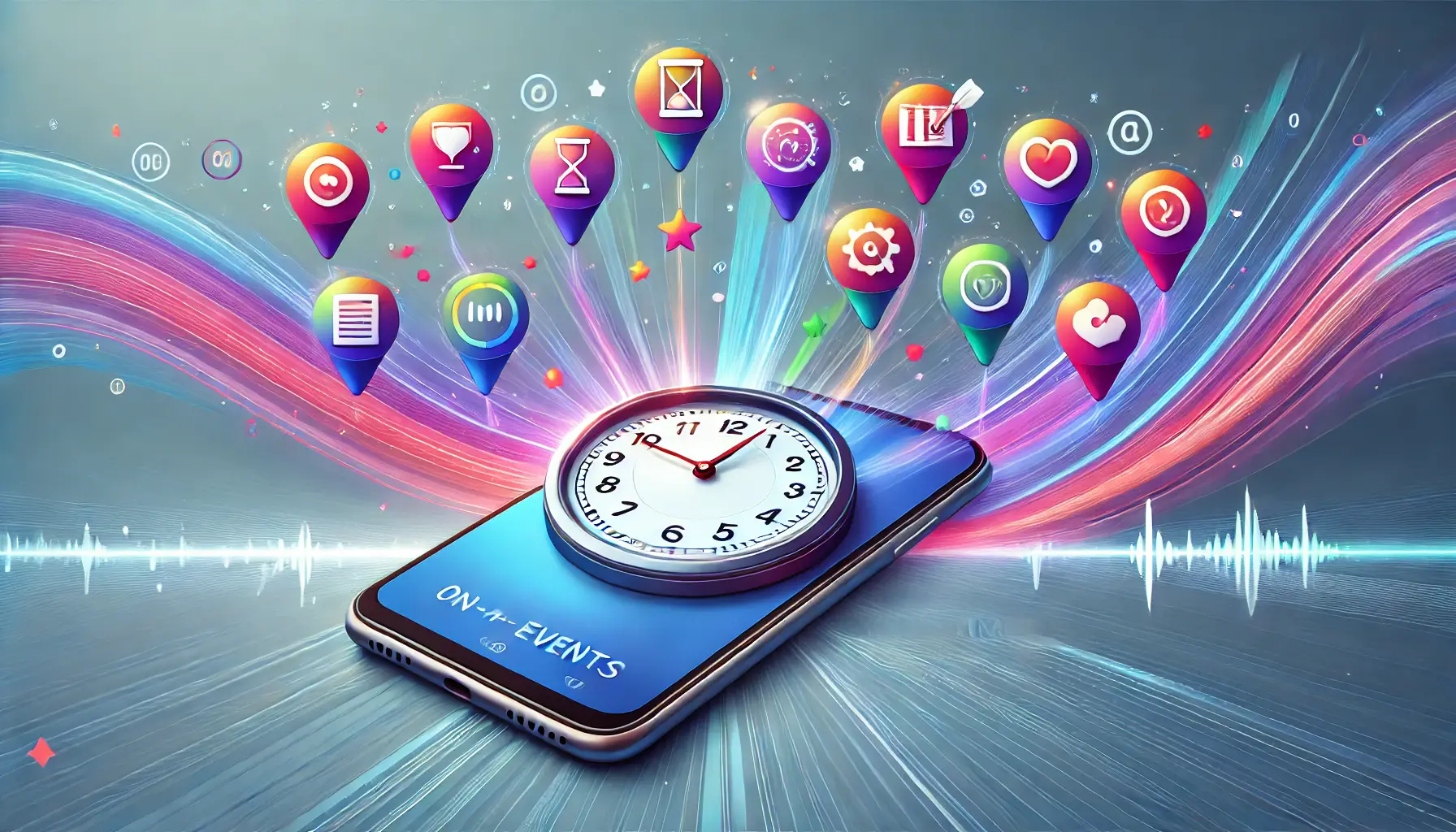
Visualizing the strategic timing of in-app events to maximize exposure and engagement.
Timing Your Events to Increase Exposure
Timing is everything when it comes to the success of in-app events.
Coordinate key events to coincide with peak user times or when your target audience is most likely to engage.
- Peak hours: Launch your events when users are most active. For many apps, weekends or holidays produce the best results.
- Duration of event: Keep your events short and impactful. Short, high-energy events create excitement and urgency, whereas longer events may tire out users.
- Events calendar: Stay updated with market trends and align your events with significant dates or industry movements. Planning your events calendar ahead of time ensures that your in-app events are timely and relevant.
With a smart selection of in-app events, you can boost your app’s visibility, ultimately leading to higher downloads and engagement.
Illustrating the importance of tracking and evaluating in-app event performance through analytical tools and metrics.
Tracking and Evaluating Event Performance
To improve your in-app events over time, measuring their success is essential.
Analytics tools are vital in tracking user engagement, retention, and conversion ratesThe percentage of users who take a desired action, such as making a purchase or signing up. during and after the event.
- Engagement metrics: Track how many users participate in your event, how long they engage with it, and which features they enjoy most.
- Conversion rates: Calculate how many event attendees convert into paying users or perform other desired actions, such as subscribing to newsletters or making purchases.
- User feedback: Gather feedback from users on their event experience. Use this information to refine and improve future in-app events.
By closely tracking and evaluating performance data, you can optimize your in-app events to be more relevant and effective, driving even better ASO results moving forward.
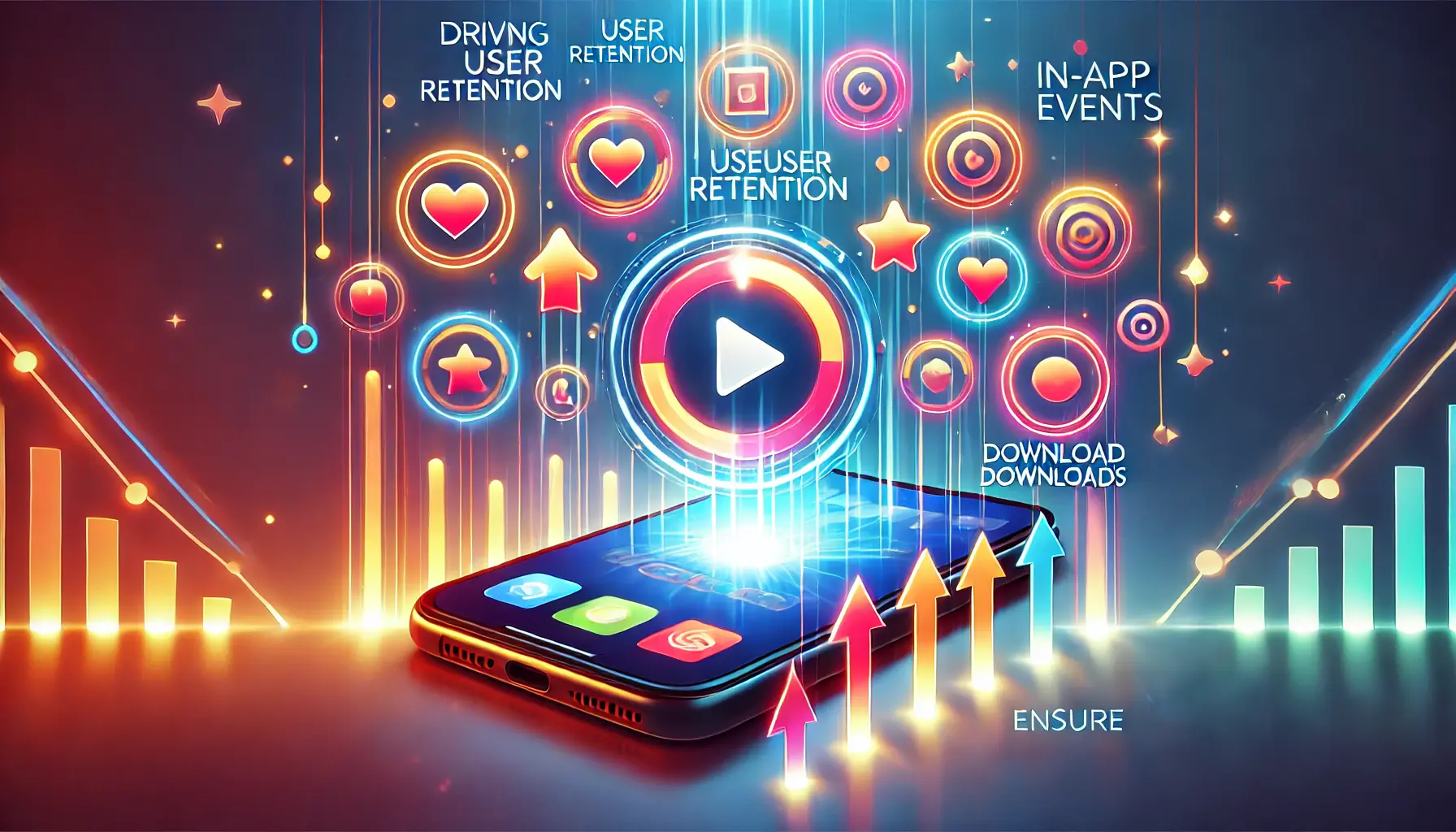
Illustrating the role of in-app events in boosting user retention and driving new downloads.
Driving User Retention & Downloads through In-App Events
One of the major advantages in-app events offer is that they strengthen user retention, which ultimately leads to better download rates.
By keeping frequent and engaging content, you can create a habit for users to pick up your app regularly.
This increased engagement inevitably leads to higher retention rates and an influx of new downloads, which helps improve your ASO.

Illustrating the impact of event-driven updates in driving user engagement and activity.
Driving User Engagement with Event-Driven Updates
Event-driven content is one of the most successful methods to ensure users return to your app time and again.
These updates introduce new functionality, rewards, or features that keep your users engaged and motivated.
- Challenge-based events: Events with contests or challenges that users can strive toward develop higher engagement rates. Whether it’s advancing to level 10 in a game or completing rewards in a fitness app, users love the feeling of accomplishing something.
- Reward-based updates: Distributing exclusive rewards during in-app events can incentivize users to participate. Features such as exclusive content, discounts, and badges can enhance user engagement in your app.
By keeping user engagement fresh and event-driven, you can maximize retention, which in turn positively affects your ASO.

Illustrating how strategic event design can enhance long-term user retention through well-planned in-app events.
Strategic Event Design for Longer User Retention
To significantly impact user retention, your in-app events need to be strategically designed to suit your users’ preferences and behaviors.
Consider what excites your users and what drives their engagement when designing your events.
- Custom events: Adapt your events to user behavior by creating custom segments. For example, offer beginner challenges for new users and advanced-level events for long-term users. Personalization leaves users convinced that events are tailored just for them.
- Scheduled events: Regular and predictable events keep users active. When users expect regular updates or events, they are more likely to stay engaged and look forward to future pushes.
Not only will strategic event design increase retention rates, but it will also boost your app’s ranking and visibility in the App Store’s algorithm.
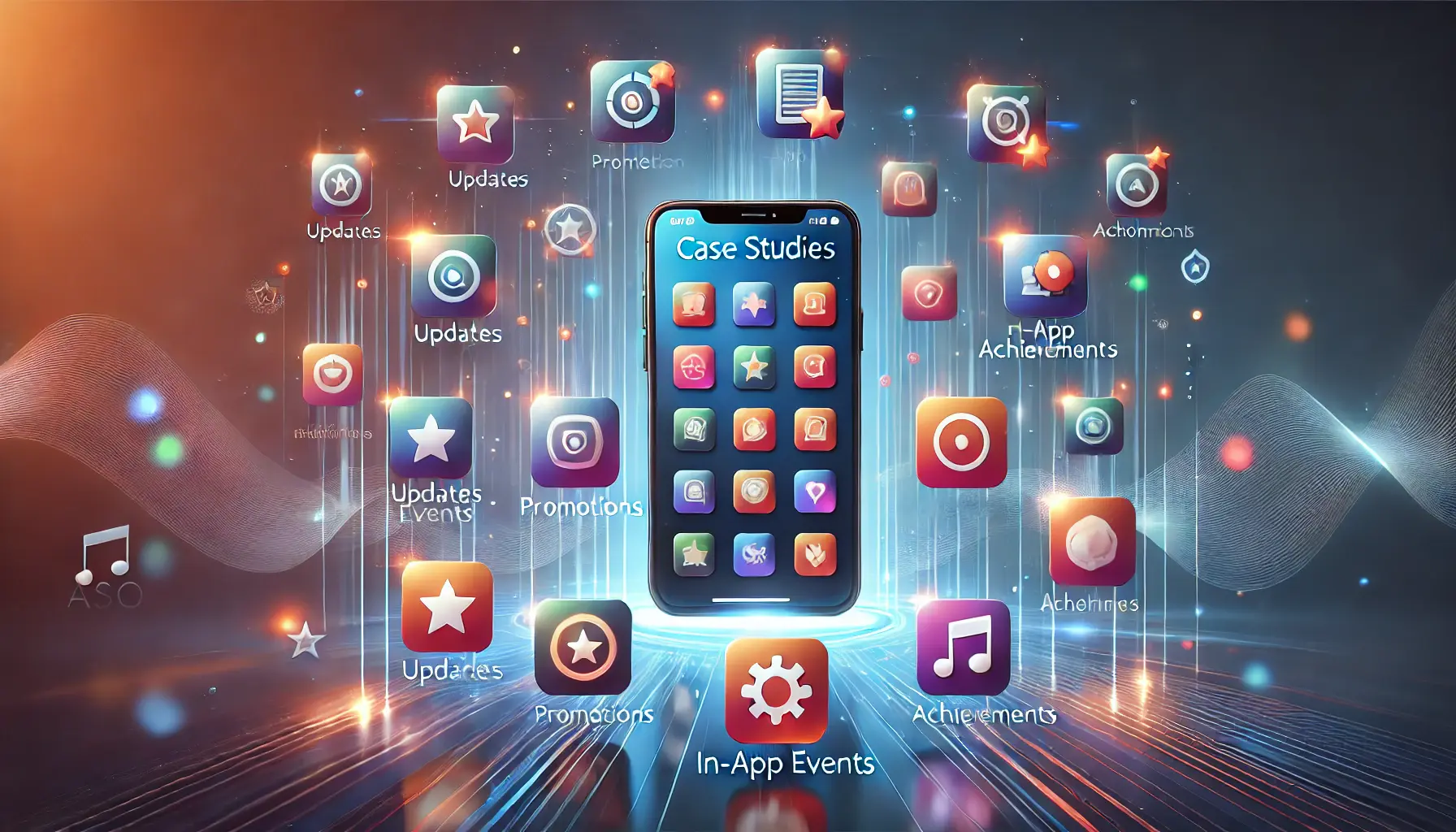
Illustrating how various apps have successfully leveraged in-app events like promotions and updates to boost ASO performance.
Case Studies: Apps That Have Effectively Used In-App Events for ASO
Looking at apps that have effectively used in-app events to drive user engagement and ASO success can provide valuable insights for your own app.
Here are a few examples:
- Example 1: Pokémon GO
- Example 2: Fortnite
- Example 3: Duolingo
The in-app events in these examples contribute to long-term engagement, making them key components of a successful ASO strategy.
Adopting similar acquisition strategies can help you increase user retention and improve your app’s rankings.
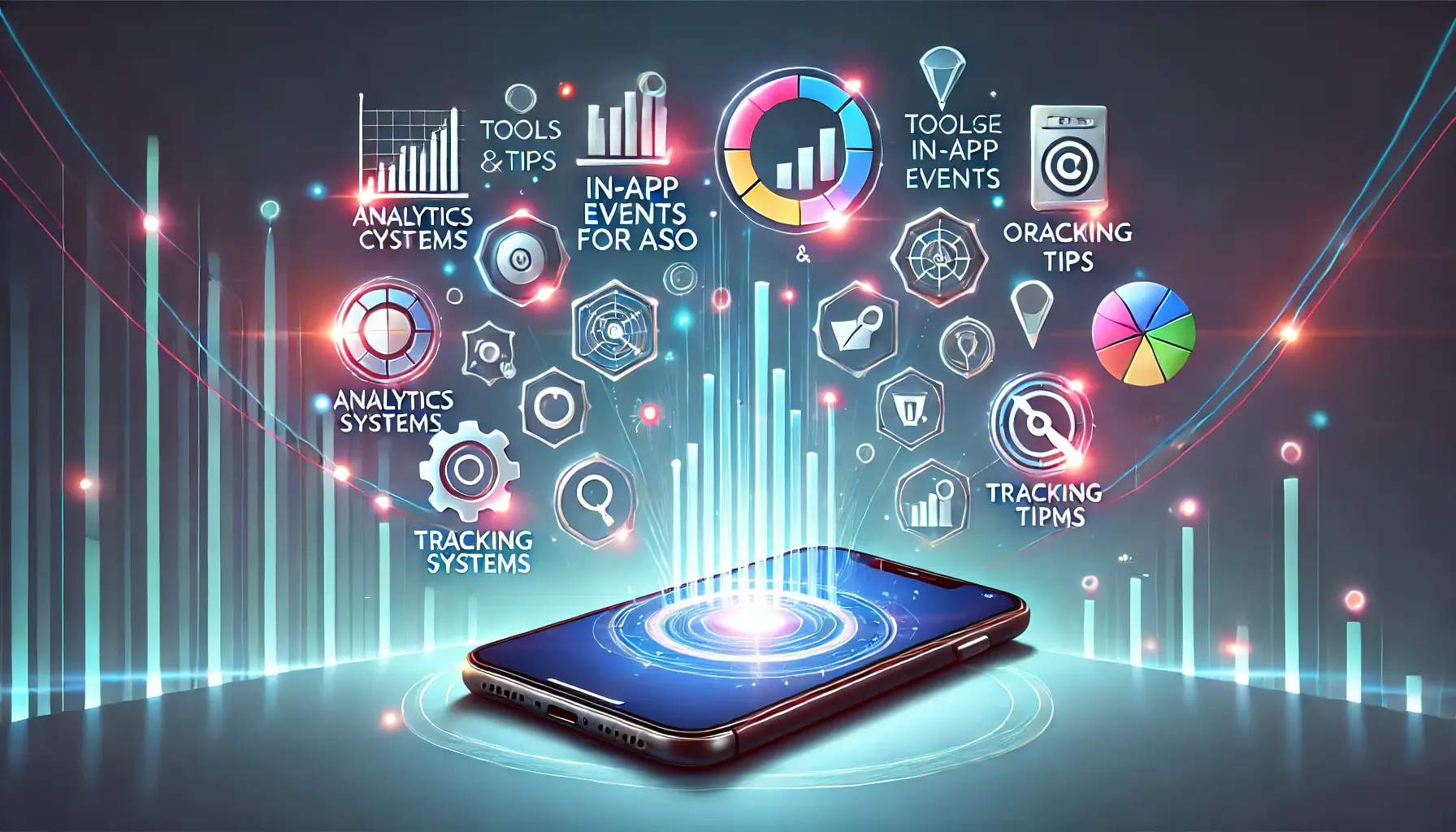
Illustrating the tools and tips necessary for effectively managing in-app events to boost ASO performance.
10 Tools and Tips to Manage In-App Events for ASO
To harness the power of in-app events for better ASO, you need access to certain tools and strategies.
Having the right tools for every job will ensure that you analyze event performance, refine your strategy, and optimize your events for maximum impact.
Highlighting the best ASO tools for tracking and optimizing in-app event performance.
Best ASO Tools for Tracking In-App Event Performance
Tracking how your in-app events are performing is crucial.
This allows you to see what is working and what isn’t.
Several tools can help you refine your events to have a perfect optimized ASO impact.
- App Annie: A powerful tool that provides detailed app analytics, including downloads, rankings, and in-app engagement related to your events.
- Sensor Tower: Sensor Tower is excellent for tracking how your app and your competitors are performing. You can track keyword rankings and monitor spikes in traffic due to in-app events.
- Google Analytics: Used for tracking user behavior inside your app. It helps you track your in-app events, how users are interacting with them, conversion rates, user engagement, and more.
These tools are invaluable for defining your in-app events and setting KPIs to help improve your ASO results.
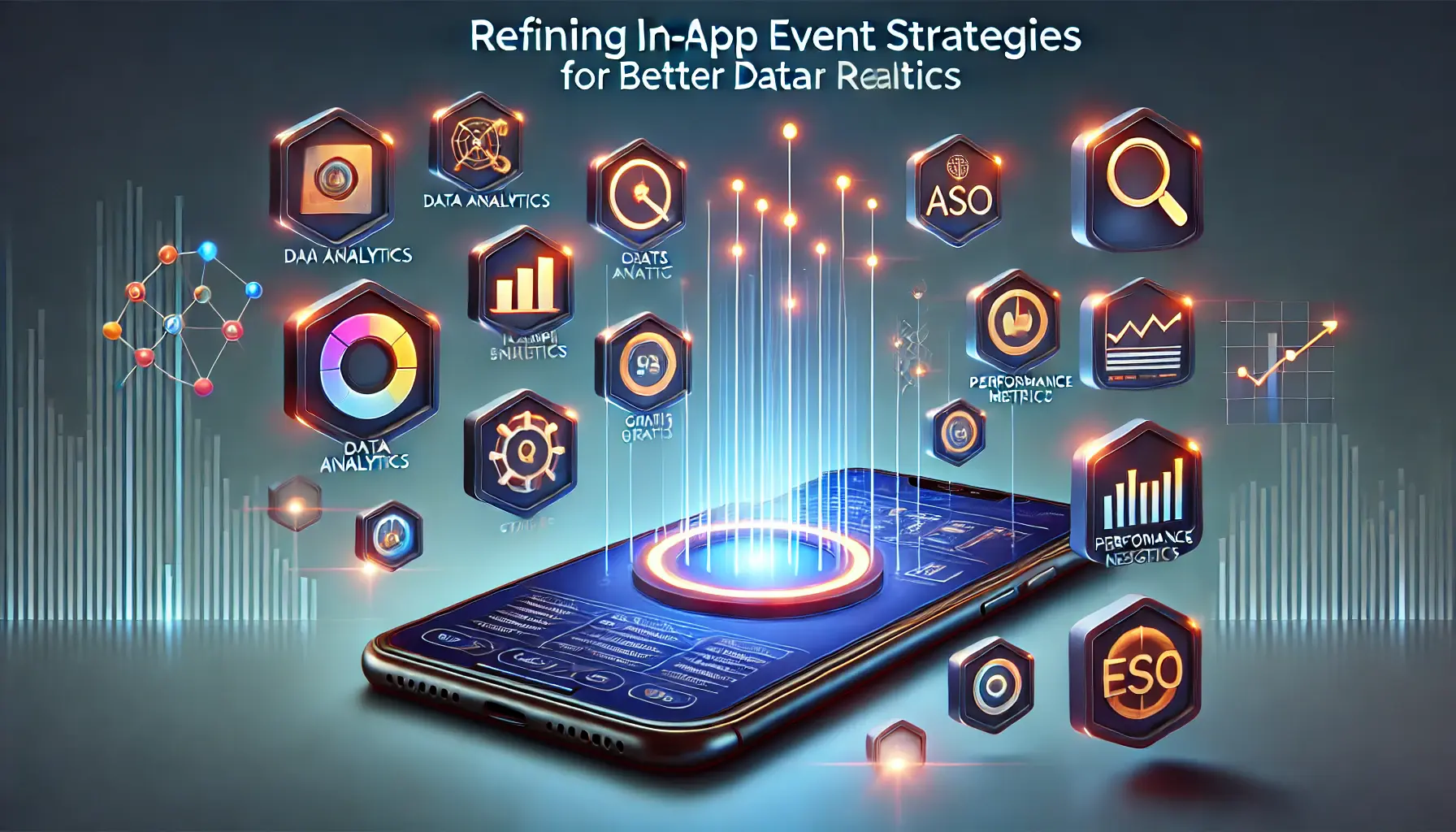
Visualizing the use of data analytics to refine in-app event strategies for better ASO results.
Refine Event Strategies with Data Analytics
Refining your in-app event strategy using data analytics is key to increasing engagement and retention.
By analyzing data from your events, you can identify what works best for your audience and adjust your strategy to fit user needs, thereby boosting ASO performance.
- Engagement trends: Learn which high-performing event types generate the most engagement and focus on organizing similar events.
- User demographics: Data analytics can help you understand which types of users are engaging most with your events. Customize future events to the preferences of your most engaged users.
- Performance metrics: By tracking KPIs like downloads, session times, and conversion rates, you can precisely evaluate the effectiveness of your in-app events. Use this knowledge to enhance future event offerings and drive your app’s visibility in the App Store.
Using data analytics to fine-tune your event strategy will help you stay ahead of the competition and maintain strong ASO performance.
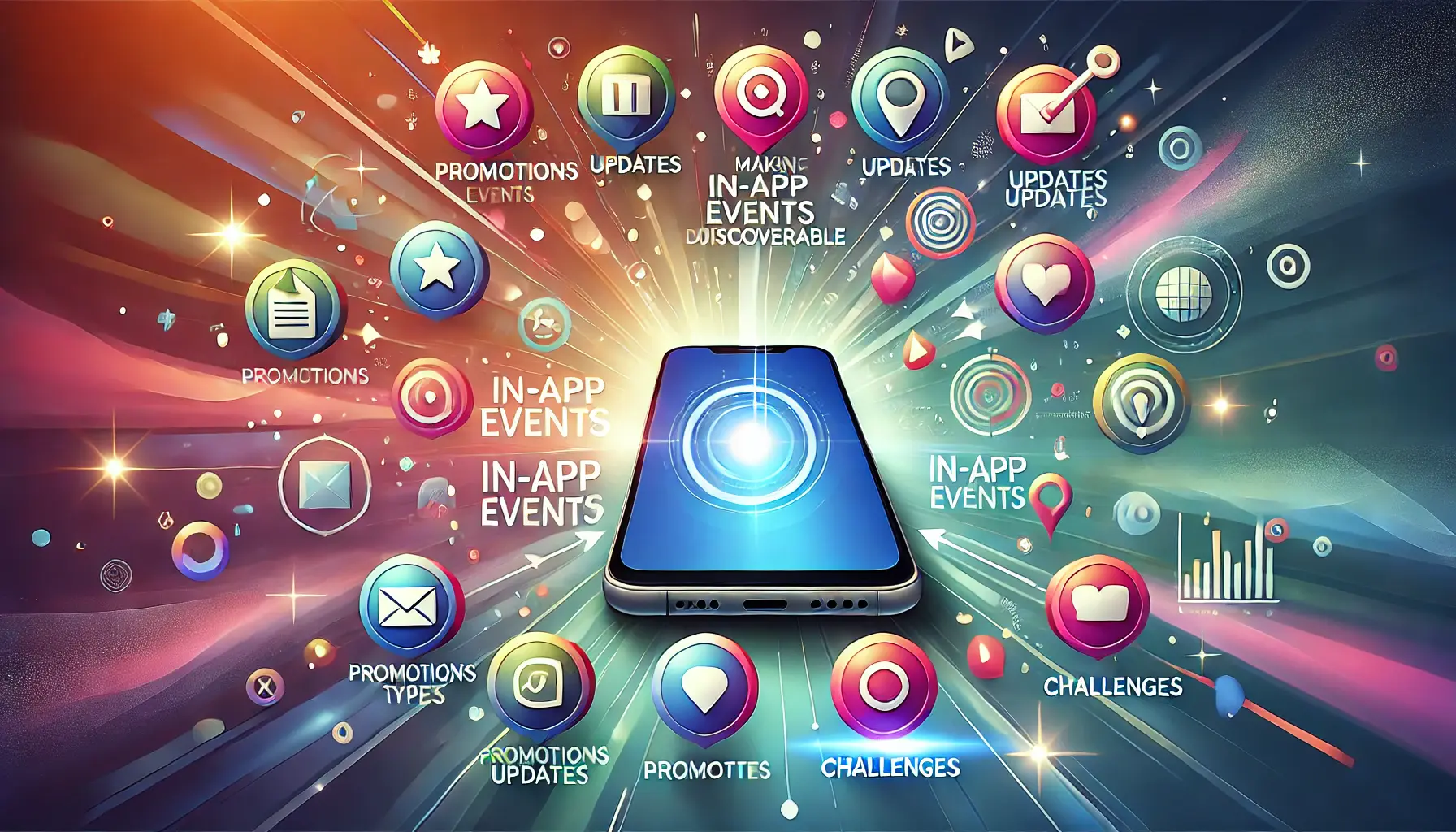
Illustrating how to make in-app events more discoverable with a focus on visibility and reach.
How to Make Your Events More Discoverable: A Practical Guide
Your in-app events should adhere to best practices for ASO if they are going to effectively fuel your app’s discoverability.
- Keywords: Use relevant target keywords in your event listings. These are the terms potential attendees are likely to search for, which will increase your app’s visibility and improve its ranking in search results.
- Promote your events: Don’t rely solely on the App Store for promotion. Leverage social media, email newsletters, and other marketing channels to inform people about your events and attract more users to your app.
- Highlight event benefits: Ensure your listings clearly communicate the value of your in-app events. Promote exclusive rewards, fresh features, and limited-time offers to entice users to participate.
By following these best practices, you can improve your in-app events for better discoverability and optimize your overall ASO strategy.
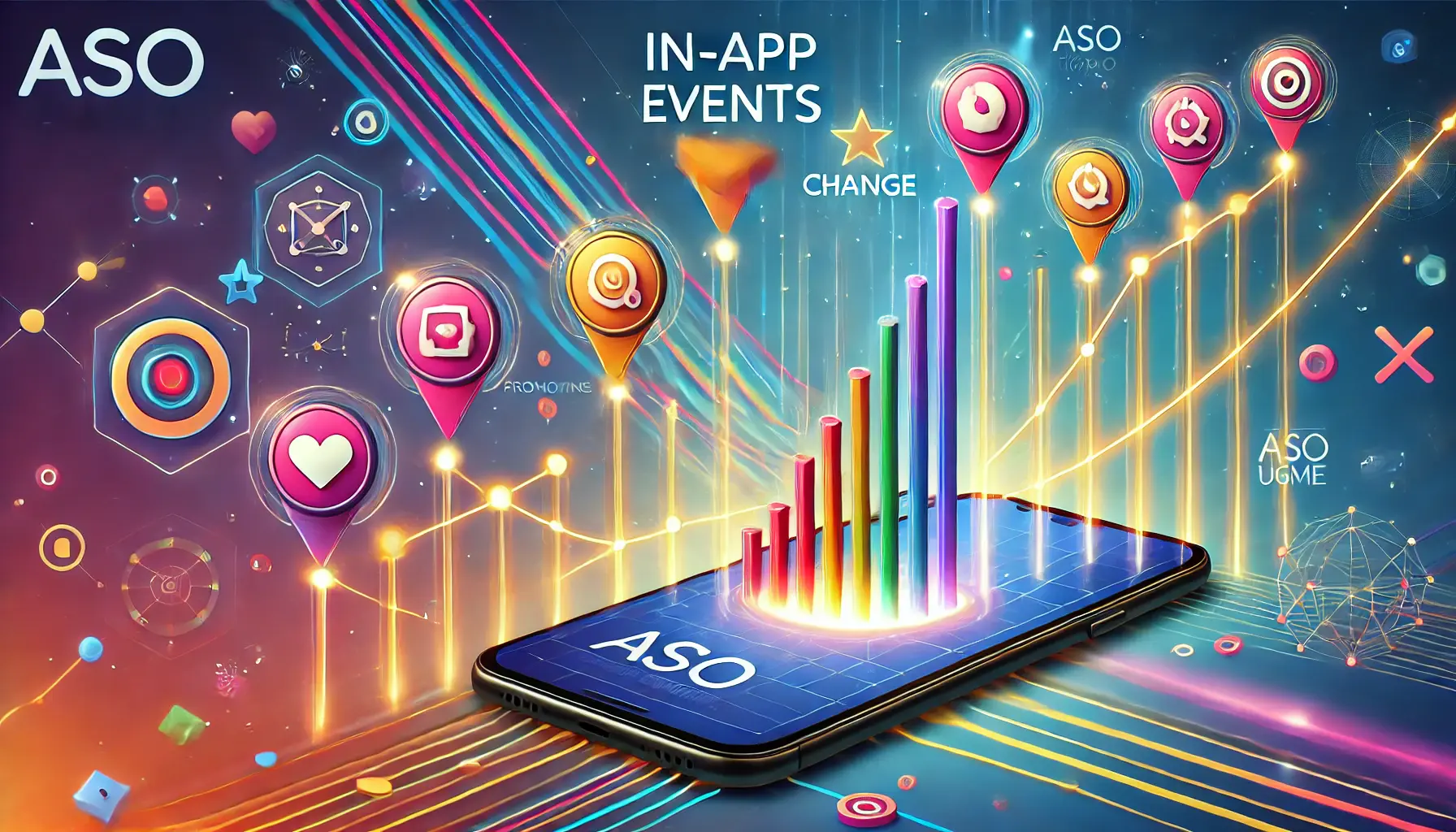
Illustrating how in-app events can transform ASO performance by driving growth and success.
How In-App Events Can Change Your ASO Game
In this article, we covered how important in-app events are when it comes to ASO (App Store Optimization) and visibility of your apps.
When done correctly, these events have amazing potential to boost user engagement with your app and drive retention and downloads.
By utilizing the correct strategies and tools, you can enhance your app performance in the App Store and Play Store, which ultimately results in long-term sustainability.
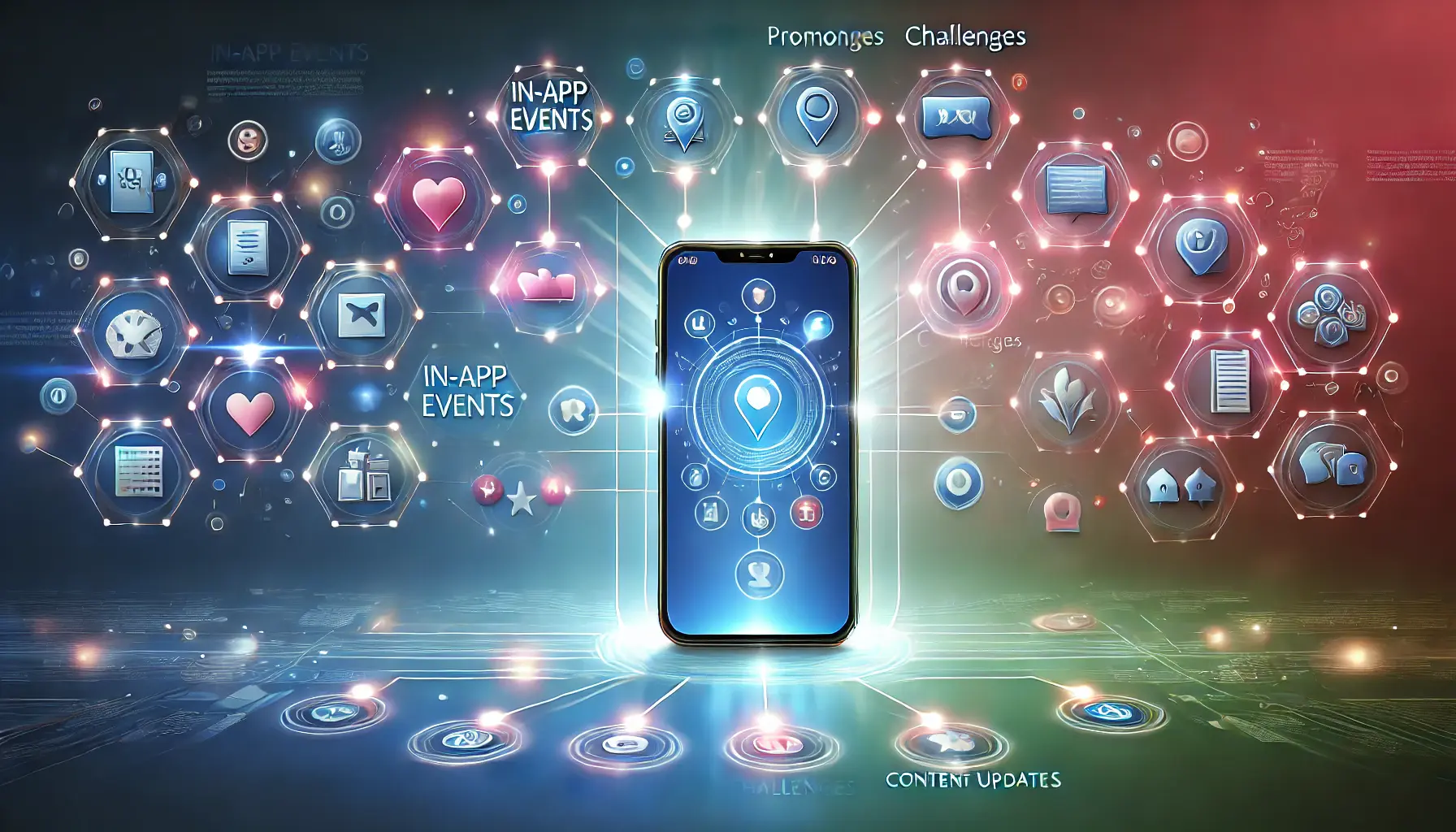
Illustrating the proper use of in-app events through a structured and strategic approach.
Summing Up — Proper Use of In-App Events
With in-app events playing a more crucial role in your ASO strategy, creative experimentation combined with data-driven strategies is essential to success.
Here are the key insights to remember:
- Strategic focus: Your in-app events are only as successful as the events you choose. They must align with your targeted end-users via promotions, achievements, and seasonal activations. Customize every event according to the profile of your audience.
- Frequent updates: Keep your app fresh and exciting by providing new event-based updates. This not only retains current users but also brings in new ones, helping your app continue to rank high.
- Data analytics: Analyze event performance using data provided by in-app events to better understand trends in user engagement, demographics, and KPIs. This ensures that your engagements improve over time.
- Marketing and discoverability: Don’t rely solely on the App Store for app promotion. Utilize multiple marketing methods like social media and newsletters to spread the word about your events.
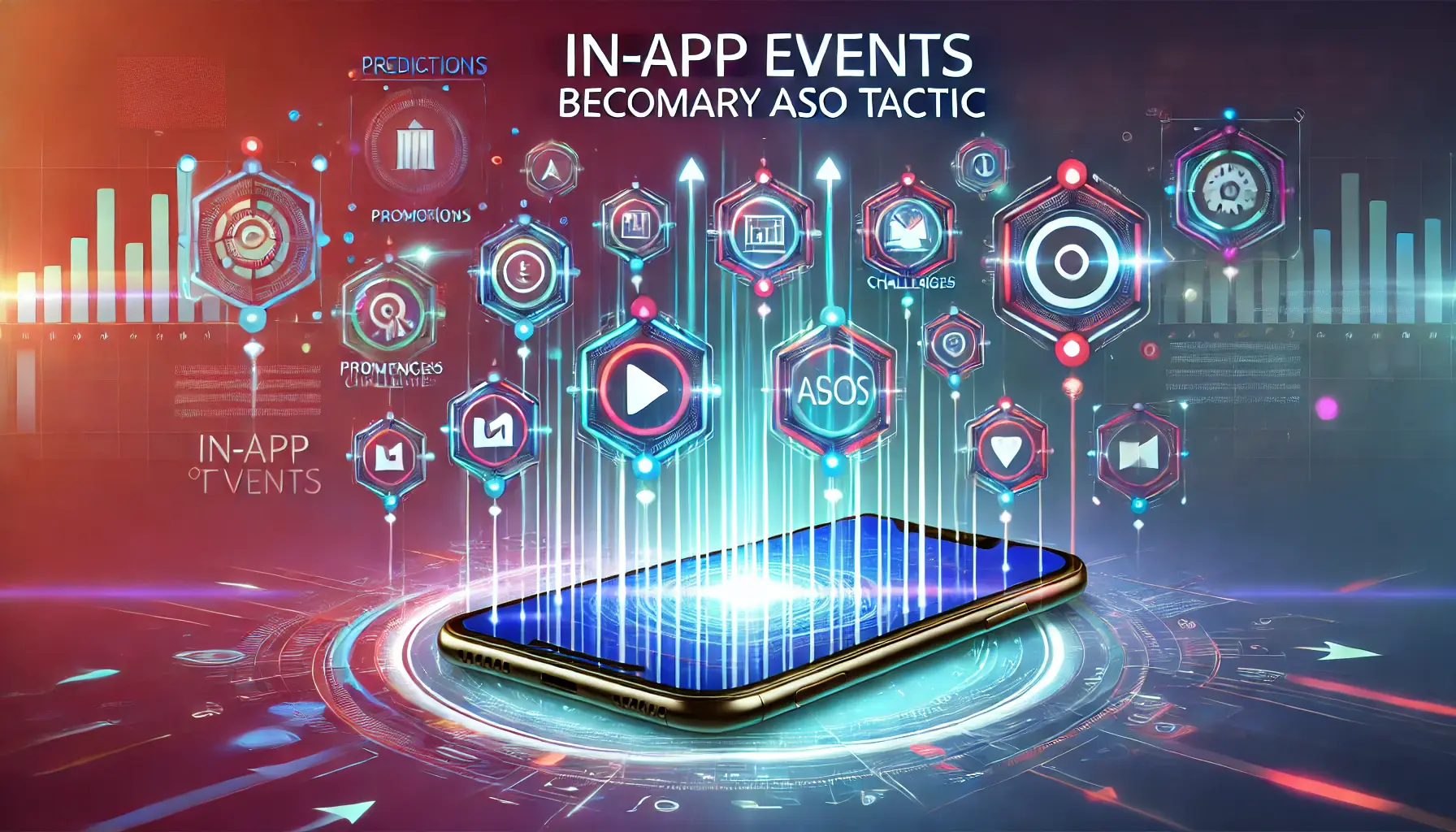
Illustrating predictions of in-app events becoming a primary ASO tactic with a forward-looking and futuristic design.
Our Predictions: Deeper Into In-App Events as a Primary ASO Tactic
With the app marketplace becoming increasingly saturated, including in-app events into your ASO strategy is more crucial than ever.
Following best practices for creating, timing, and promoting events in your app will help you stay ahead of the competition by keeping more users engaged.
Using data to fine-tune your events will enable you to stay current and ensure continued engagement from users.
In the world of rapidly developing apps, this is crucial—taking the time to invest in in-app events can prove to be a strategic move toward long-term growth.
These events can be powerful in helping you achieve major goals such as higher retention rates, more downloads, and better app rankings.
If you put into action all of the strategies covered in this article, you will have already started your journey toward mastering in-app events for ASO success.
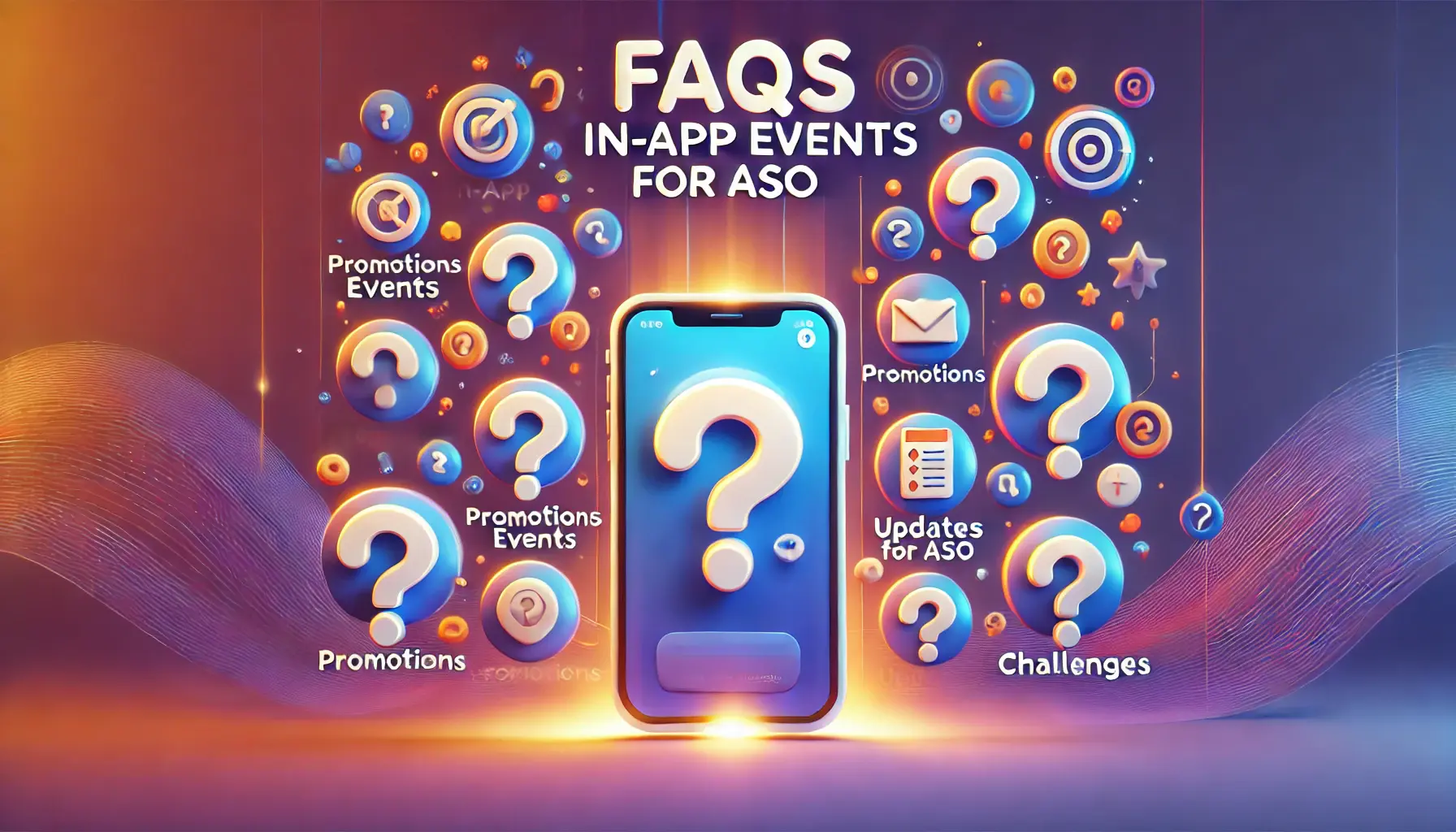
Visualizing common questions and answers about in-app events for ASO through dynamic icons and symbols.
Boost your mobile app's success with our guaranteed App Store Optimization (ASO) service. Leave it to the experts!
In-App Events for ASO: FAQs
In-app events are a powerful tool for App Store Optimization (ASO).
Here are a few questions that publishers often consider before using in-app events to boost app rankings and improve performance.
In-app events are time-bound actions within apps, such as offers, new features, or tasks that help retain user attention.
They drive visibility, sales, and download rankings in the App Store and Play Store.
In-app events improve ASO by boosting user engagement, increasing downloads, and enhancing app rankings.
They attract both existing and new users through promotions and updates, signaling added value to app store algorithmsA set of rules used by the app stores to determine app rankings and visibility..
Tools like App Annie, Sensor Tower, and Google Analytics are widely used to track in-app event performance, revealing user engagement, downloads, and rankings as part of event-driven ASO strategies.
Frequent updates to in-app events help keep your app relevant and engaging.
Regular updates encourage existing users to stay active and attract new users, which is crucial for maintaining strong app visibility and rankings.
Yes, in-app events can significantly boost user retention.
They keep users interested in your app, encouraging regular returns and reducing churn by consistently offering new experiences and incentives.
Promote your in-app events through social media, email newsletters, and other marketing channels.
These strategies help attract more users and increase your app’s overall visibility beyond the app store itself.
Seasonal in-app events can positively impact app rankings by aligning with user behavior during holidays or peak times.
These events create urgency and excitement, driving installs and engagement that boost ASO performance.










